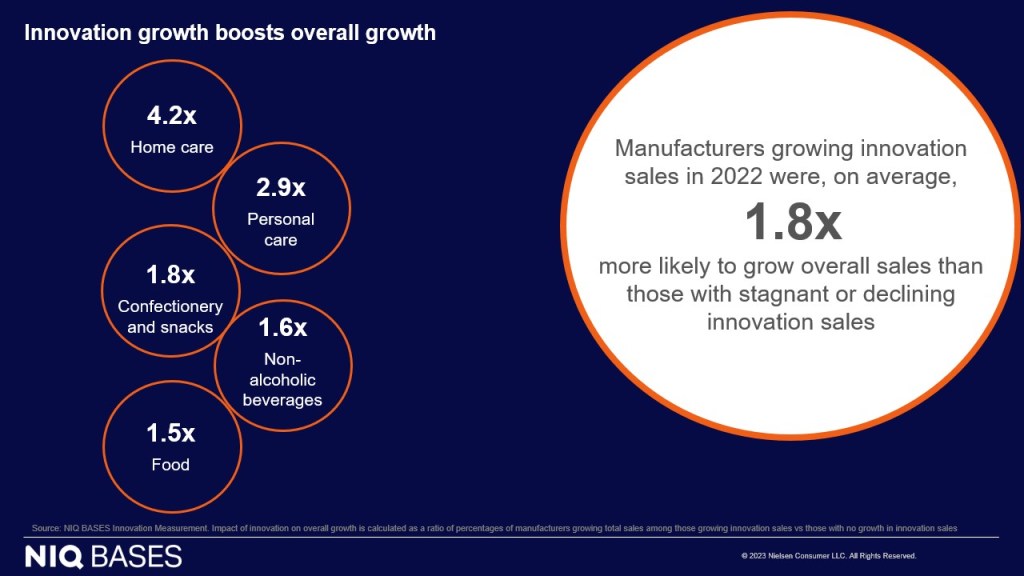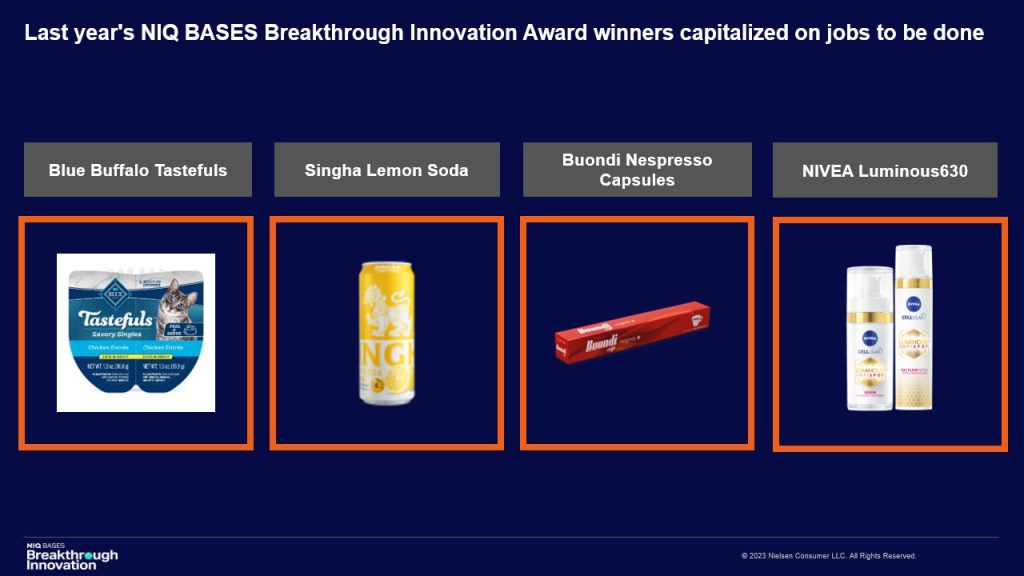What makes for a great innovation?
Have you ever tried to mimic your favorite coffeehouse drink at home? Or squeeze a citrus slice into your sparkling water to enhance the taste? If so, you’re probably aware of fast-growing retail market innovations like name-brand coffeehouse drinks and flavored sparkling waters. It’s no surprise that top performers keep a pulse on consumer behaviors and capitalize on opportunities when they find a gap in the marketplace.
What makes innovations great? It isn’t a trendy ingredient, attribute, or cutting-edge technology (although all of these things might comprise a successful new product). Instead, great innovations solve consumer problems — and they do it better than anyone else.
Celebrating Breakthrough Innovations and “Wavemakers”
Nowhere is the concept of “jobs to be done” better illustrated than in our annual BASES Breakthrough Innovation Awards, which recognizes some of the best new products from around the globe — innovations that reshaped their categories, broke through the clutter, and achieved vitality. New to our awards this year is innovation “Wavemakers”— promising new launches with strong velocities. In our upcoming webinars, we’ll delve into how these innovations claimed white space, activated effectively, and fulfilled the job to be done.
Innovation is worth the pursuit
Our data shows that when innovation sales grow, a company is, on average, 1.8 times more likely to increase overall sales as compared with companies whose innovation sales are stagnant or declining.

But for too long, the myth that “95% of all new products fail” has been an imagined barrier for innovators. The good news is that the actual data paints a much different picture: Our research shows that 52% of innovations with national distribution grow sales in their second year as compared to their first year — what we call “innovation vitality.” The vitality rate for products with limited distribution (a minimum of 1% of all commodity value) is 31%. And there’s an opportunity to win whether you’re a big, medium, or emerging brand.
Simply put: When it comes to innovation, the payoff is worth the pursuit. So, how do innovators increase their odds of achieving vitality?
Great innovations start with a “job to be done”
It turns out that people don’t so much buy products as hire them to perform jobs in their lives. But what exactly is a “job” in the context of innovation?
Consumers turn to certain brands to address circumstances where they need some help resolving a struggle or fulfilling an aspiration. Consequently, to develop successful innovations, you need a deep understanding that centers neither on the consumer nor on the product but rather on the circumstance.
Successful innovations resolve circumstances of struggle and fulfill unmet aspirations: They perform jobs that formerly had only inadequate or nonexistent solutions.
Understanding the job reveals why (the cause) people purchase and use products and services and why they sometimes behave in ways that involve no purchase at all (nonconsumption).
So, how do you identify jobs to be done? Here are some common indicators of marketplace gaps:
- Tradeoffs: Circumstances of compromise where consumers must choose between imperfect alternatives.
- Unexpected uses: Using products in unexpected ways or to deliver benefits that weren’t prioritized.
- Workarounds: A compensating routine to deal with a job that has only imperfect solutions.
- Hiring and firing moments: The reason a consumer ultimately tries or renounces a product.
You can then identify the circumstance-specific criteria that people apply in evaluating potential solutions and the emotional and social dimensions of perceived benefits, which helps you develop the ideal solution. Looking at innovation through this lens — rather than product attributes or trends — helps you develop solutions to poorly performed jobs.
Let’s illustrate this concept further by highlighting a few BASES Breakthrough Innovation Award winners from last year:

Blue Buffalo, North America
In North America, pet food brand Blue Buffalo saw an opportunity to naturalize wet cat food by combining great taste with high-quality, natural ingredients. Initial research found that pet parents had an “ick-factor” when it came to existing wet cat food offerings and felt there were inconvenient storage options for leftover product. Consumers made a tradeoff by compromising on perceived flavor and quality and found workarounds to inconvenient packaging by wrapping half-empty cans in plastic and storing them in the fridge for later. So Blue Buffalo created Tastefuls, which helped solve these pain points through a product that led with great taste and offered innovative new packaging with its “Savory Singles” line.
Singha, Thailand
In Thailand, local beer brand Singha entered a new category with a first-of-its-kind, zero-calorie lemon drink. This innovation addressed the compensating behavior of consumers who typically make their own mocktails with a squeeze of lemon at home. But what set Singha Lemon Soda apart was its ability to capitalize on unexpected uses. Usually, a carbonated soft drink product is positioned and advertised as a standalone refreshment — but Singha Lemon Soda saw an opportunity from consumers who liked to experiment with their drinks. Building off their active social media presence, Singha regularly interacted and engaged with consumers who, in return, shared their secret recipes on social channels. This activation grew brand engagement, which translated into increased trial and repeat purchases. Singha Lemon Soda became the market leader within their segment.
Buondi, Portugal
In Portugal, the Nestlé-owned brand Buondi was able to democratize the coffeehouse experience with its espresso capsules. Historically, Portugal has been an out-of-home coffee market, with over 60% of overall consumption occurring in places like cafés and restaurants. But there’s also been a significant increase in single-serve espresso machines — in 2020, two-thirds of Portuguese homes had one in their kitchen. Consumers who previously made a tradeoff between an expensive, inconvenient trip to the coffee shop and lower-quality at-home offerings now had a trusted local brand, which was more affordable yet still premium, that they could make at home with their Nespresso machine.
NIVEA, Europe
In Europe, NIVEA identified a gap in the skincare marketplace. Consumers were looking for an anti-spot skincare solution, but the only available products from pharma and selective channels were too expensive, while ingredients used for mass markets were either too harsh or ineffective — a “hiring and firing” moment for consumers who renounce under-performing products. After 10 years of meticulous research testing more than 50,000 possible active ingredients, NIVEA scientists discovered that molecule number 630 was the most successful in balancing pigmentation production and reducing dark spots. Their new skincare line based on this finding, Luminous630, reduces spots caused by sun, aging, and hormonal factors and prevents their reappearance. In the first year after its launch, Luminous630 became the number 1 serum in Europe.
Create a beautiful marriage
In the words of BASES Managing Director Ramon Melgarejo, “Companies that innovate most effectively are the ones that create a beautiful marriage between defined marketplace gaps and brand strengths.” By working backward from marketplace needs instead of forward from their capabilities, innovators can identify compelling business opportunities aligned with their organization’s strengths and priorities. And by delivering a product that meets or exceeds consumers’ expectations, they can ultimately achieve long-term growth and vitality.

Want even more inspiring examples of breakthrough innovation?
Learn from the winners and Wavemakers of our 2023 BASES Breakthrough Innovation Awards. Register to attend our upcoming webinars, or contact your BASES representative to learn about the upcoming release of our Breakthrough Innovation Report.



